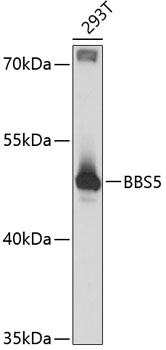Cell Biology Antibodies 3
Anti-BBS5 Antibody (CAB12681)
- SKU:
- CAB12681
- Product Type:
- Antibody
- Reactivity:
- Human
- Host Species:
- Rabbit
- Isotype:
- IgG
- Antibody Type:
- Polyclonal Antibody
- Research Area:
- Cell Biology
Description
| Antibody Name: | Anti-BBS5 Antibody |
| Antibody SKU: | CAB12681 |
| Antibody Size: | 20uL, 50uL, 100uL |
| Application: | WB |
| Reactivity: | Human |
| Host Species: | Rabbit |
| Immunogen: | Recombinant fusion protein containing a sequence corresponding to amino acids 1-341 of human BBS5 (NP_689597.1). |
| Application: | WB |
| Recommended Dilution: | WB 1:500 - 1:2000 |
| Reactivity: | Human |
| Positive Samples: | 293T |
| Immunogen: | Recombinant fusion protein containing a sequence corresponding to amino acids 1-341 of human BBS5 (NP_689597.1). |
| Purification Method: | Affinity purification |
| Storage Buffer: | Store at -20'C. Avoid freeze / thaw cycles. Buffer: PBS with 0.02% sodium azide, 50% glycerol, pH7.3. |
| Isotype: | IgG |
| Sequence: | MSVL DALW EDRD VRFD LSAQ QMKT RPGE VLID CLDS IEDT KGNN GDRG RLLV TNLR ILWH SLAL SRVN VSVG YNCI LNIT TRTA NSKL RGQT EALY ILTK CNST RFEF IFTN LVPG SPRL FTSV MAVH RAYE TSKM YRDF KLRS ALIQ NKQL RLLP QEHV YDKI NGVW NLSS DQGN LGTF FITN VRIV WHAN MNDS FNVS IPYL QIRS IKIR DSKF GLAL VIES SQQS GGYV LGFK IDPV EKLQ ESVK EINS LHKV YSAS PIFG VDYE MEEK PQPL EALT VEQI QDDV EIDS DGHT DAFV AYFA DGNK QQDR EPVF SEEL GLAI EKLK DGFT LQGL WEVM S |
| Gene ID: | 129880 |
| Uniprot: | Q8N3I7 |
| Cellular Location: | Cell projection, Cytoplasm, centriolar satellite, centrosome, cilium basal body, cilium membrane, cytoskeleton, microtubule organizing center |
| Calculated MW: | 36kDa/38kDa |
| Observed MW: | 48kDa |
| Synonyms: | BBS5 |
| Background: | This gene encodes a protein that has been directly linked to Bardet-Biedl syndrome. The primary features of this syndrome include retinal dystrophy, obesity, polydactyly, renal abnormalities and learning disabilities. Experimentation in non-human eukaryotes suggests that this gene is expressed in ciliated cells and that it is required for the formation of cilia. Alternate transcriptional splice variants have been observed but have not been fully characterized. |
| UniProt Protein Function: | BBS5: The BBSome complex is required for ciliogenesis but is dispensable for centriolar satellite function. This ciliogenic function is mediated in part by the Rab8 GDP/GTP exchange factor, which localizes to the basal body and contacts the BBSome. Rab8(GTP) enters the primary cilium and promotes extension of the ciliary membrane. Firstly the BBSome associates with the ciliary membrane and binds to RAB3IP/Rabin8, the guanosyl exchange factor (GEF) for Rab8 and then the Rab8-GTP localizes to the cilium and promotes docking and fusion of carrier vesicles to the base of the ciliary membrane. Defects in BBS5 are a cause of Bardet-Biedl syndrome type 5 (BBS5). Bardet-Biedl syndrome (BBS) is a genetically heterogeneous disorder characterized by usually severe pigmentary retinopathy, early onset obesity, polydactyly, hypogenitalism, renal malformation and mental retardation. Secondary features include diabetes mellitus, hypertension and congenital heart disease. A relatively high incidence of BBS is found in the mixed Arab populations of Kuwait and in Bedouin tribes throughout the Middle East, most likely due to the high rate of consaguinity in these populations and a founder effect. Belongs to the BBS5 family. 2 isoforms of the human protein are produced by alternative splicing. |
| UniProt Protein Details: | Chromosomal Location of Human Ortholog: 2q31.1 Cellular Component: cytosol; intracellular Molecular Function:phosphatidylinositol 3-phosphate binding; protein binding Biological Process: heart looping; intracellular transport; melanosome transport Disease: Bardet-biedl Syndrome 5 |
| NCBI Summary: | This gene encodes a protein that has been directly linked to Bardet-Biedl syndrome. The primary features of this syndrome include retinal dystrophy, obesity, polydactyly, renal abnormalities and learning disabilities. Experimentation in non-human eukaryotes suggests that this gene is expressed in ciliated cells and that it is required for the formation of cilia. Alternate transcriptional splice variants have been observed but have not been fully characterized. [provided by RefSeq, Jul 2008] |
| UniProt Code: | Q8N3I7 |
| NCBI GenInfo Identifier: | 74750959 |
| NCBI Gene ID: | 129880 |
| NCBI Accession: | Q8N3I7.1 |
| UniProt Secondary Accession: | Q8N3I7,Q6PKN0, D3DPC3, |
| UniProt Related Accession: | Q8N3I7 |
| Molecular Weight: | 39kDa |
| NCBI Full Name: | Bardet-Biedl syndrome 5 protein |
| NCBI Synonym Full Names: | Bardet-Biedl syndrome 5 |
| NCBI Official Symbol: | BBS5 |
| NCBI Protein Information: | Bardet-Biedl syndrome 5 protein |
| UniProt Protein Name: | Bardet-Biedl syndrome 5 protein |
| Protein Family: | Bardet-Biedl syndrome 5 protein |
| UniProt Gene Name: | BBS5 |
View AllClose







